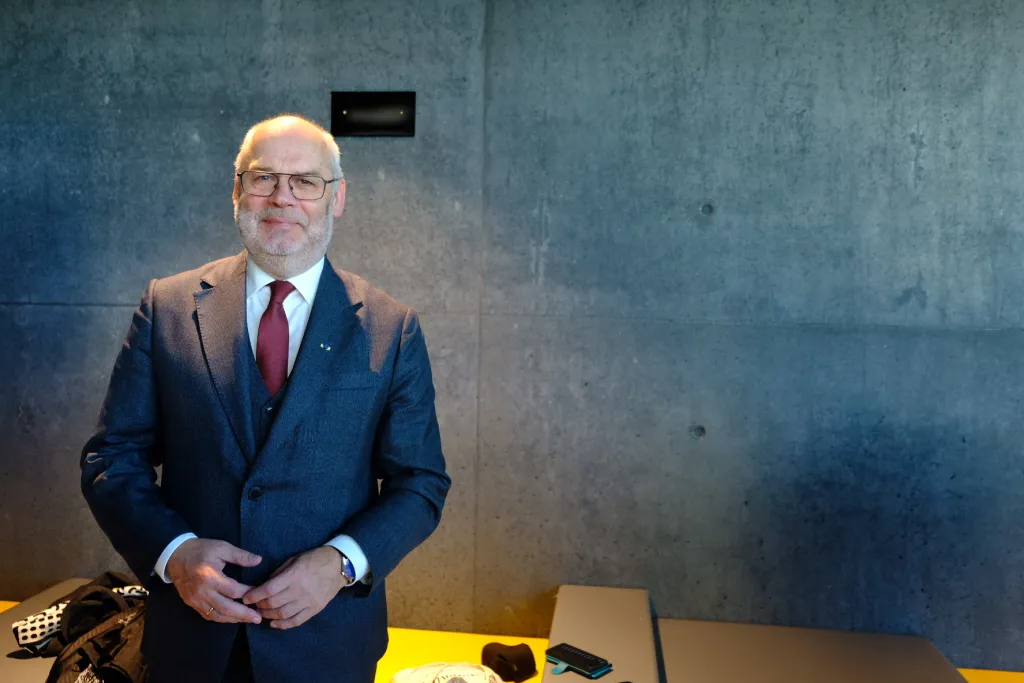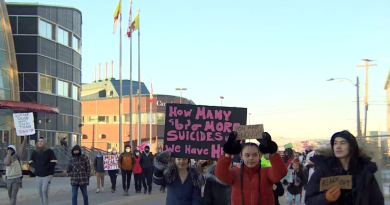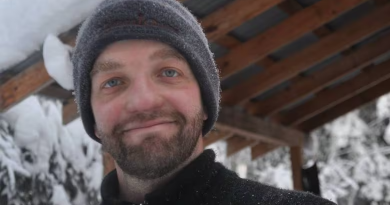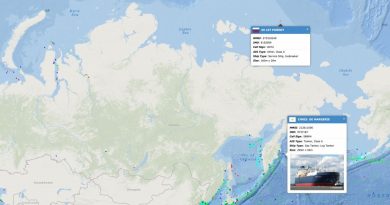BLOG: “We are trying to hand over our expertise in the Arctic”—Estonia

On the sidelines of the Arctic Circle conference, I sat down with Alar Karis, President of Estonia.
The Baltic state – a NATO and EU member and applicant for Arctic Council observer status – seeks to leverage its cultural and linguistic ties to Arctic Indigenous Peoples and offer the region its techno savoir-faire and scientific expertise.
At the Arctic Circle conference in Reykjavik, Iceland earlier this month, I interviewed Alar Karis, the President of Estonia. The Baltic republic and European Union and NATO member is a candidate for observer status in the Arctic Council. The Estonian government submitted its application in 2020, when it proclaimed itself to be “the northernmost non-Arctic country.” Although a nation of just 1.3 million people, Estonia has rich and deep-seated connections to the polar regions – and a short but critical border with Russia.
Estonian claims to Indigeneity
Estonians share cultural and linguistic affinities with other Finno-Ugric peoples. Many of these groups live in the Arctic, including the Finns, the Sámi, and the Khanty, who live in Siberia. It was from the Russian region’s frozen steppes that these originally semi-nomadic groups first spread into Europe around 10,000 years ago after the end of the last ice age.
Estonian is also a member of the Finnic language subgroup of the Uralic languages; Sami is another subgroup, as is Samoyed. This latter subgroup includes Nenets, the language belonging to the Siberian reindeer herding people.
As President Karis contended during our interview transcribed below, Estonians were once Indigenous Peoples, too. Having gained sovereignty in 1918 following the Russian revolution and again in 1991 after the collapse of the Soviet Union, Estonia believes it can share its knowledge and experience to help ensure the survival of small nations, cultures, and languages.
Estonia’s aspiration to collaborate with small nations is nothing new. After the collapse of the Soviet Union, in 1994, the Finno-Ugric countries and regions signed a cooperation Agreement of Television Organizations in Estonia. Among its signatories were the representatives of Udmurtia, Komi Gor, Tyumen, and, of course, Estonia. The Sami did not sign the agreement at the time, as their television broadcasting skills were still nascent. One publication suggested, “It is too early to say how the Sami radio and television will be integrated to these efforts and how the Sami media in the Murmansk effort would develop in this respect. But there is a growing interest to promote cultural awareness of the less privileged as well as indigenous people.” Television shows and films under the banner of the “Finno-Ugria World” were released, and an annual festival was held, too – including one once in Khanty-Mansisyk, Siberia in 1995.
| Language | fish | blood |
| Estonian | kala | veri |
| Finnish | kala | veri |
| Northern Sami | guolli | varra |
Estonian science at the crossroads of empire
Beyond cultural contributions, Estonian officials champion the country’s ability to offer scientific expertise to the Arctic. The Estonian Academy of Sciences recently named two professorships for Arctic Studies, formalizing its commitment to the field. The academy’s president, Tarmo Soomere, spoke at Arctic Circle, as did one of the recipients of the Arctic Studies professorship: Lauri Laanisto, a macroecologist researching plant communities in Svalbard.
Demonstrating the prominence of science in Estonian society and politics, Soomere sought unsuccessfully to run for president of the country in 2021. While he did not win, another scientist – Karis, a molecular geneticist, developmental biologist, and former director of the Estonian National Museum – did.
There is perhaps less willingness among Estonian officials, however, to admit the imprint of empire on national science. The country’s first university, in Tartu, was established by the King of Sweden, Gustavus II Adolphus, in 1632. A century and a half later, a man from present-day Estonia became the first known person to sight Antarctica. While a website on “Estonians in the Arctic and Antarctic” celebrates Fabian Gottlieb von Bellingshausen’s achievement as an Estonian, he was born into Baltic German nobility, a class from which many Russian imperial navigators were plucked. Bellingshausen also fought on behalf of Tsarist Russia in the Russo-Turkish War of 1828-1829. Towards the end of his life, he served as military governor of Kronstadt, a strategic Russian port near St. Petersburg.
Bellinghausen, a veteran and defender of Imperial Russia, is today celebrated as an Estonian. His name adorns bottles of Estonian vodka and the sailboat that led an expedition to Antarctica organized by the Estonian Maritime Museum to commemorate the 200th anniversary of his pioneering voyage. Yet Russian citizens resident in Estonia who answer the Kremlin’s conscription notices risk being stripped of residency. History lends fluidity to identity, while in the present, the lines are drawn hard and fast.
A once porous border with Russia
Estonia bears geopolitical similarities with its northern neighbors, too. Like the two Arctic Council member states of Norway and Finland, Estonia borders Russia. While that border has hardened in recent years, in past decades and centuries, it was far more porous. Estonia fell under control of Imperial Russia for 200 years and the Soviet Union for half a century. In 1841, English author and member of the nineteenth-century literati, Elizabeth, Lady Eastlake, published a book entitled A Residence on the Shores of the Baltic. She evocatively recounted her voyage by sea from England to St. Petersburg via Norway and Denmark and then overland to Estonia to visit her sister, who had married a nobleman of the Russian imperial governorate.
Lady Eastlake’s description of her journey by horse from St. Petersburg to Estonia illustrates the gradual transition from the snowy, icy climes of Russia to the gentler, less Arctic shores of Estonia, albeit with language that today would be considered problematic:
Reseated with fresh horses and lulled by the musical jingle of our post bells, I dozed with tolerable comfort during the night, and opened my eyes with daybreak to a perfect Esquimaux landscape, –boundless flats of snow, low hovels of wood, and peasants gliding noiselessly past on their tiny sledges.
At the town of Narva, through which the present-day border with Russia cuts, Lady Eastlake and her entourage crossed into Estonia. She reflected:
“We had now entered Estonia; the landscape was undulating and wooded, and towards evening a high-line of ocean horizon and a faint sound of waves showed me were were skirting a cliff of considerable eminence. The appearance of our horses also kept pace with the improved condition of the country. They were beautiful sleek animals, small and graceful, sometimes four cream-colours, sometimes four blacks, ‘who started with fire, never abated their speed, and pawed the ground with impatience when the five-and-twenty wersts were run.’”
ELIZABETH, LADY EASTLAKE, A RESIDENCE ON THE SHORES OF THE BALTIC (1841)
From seamless Baltic shores to Soviet annexation
For those who could afford it, the Baltic Sea littoral permitted seamless, languid travel in the nineteenth century, when both Finland and Estonia fell under the control of Imperial Russia. At the end of World War I, however, both Finno-Ugric nations gained independence from the crumbling empire in the throes of revolution. Finnish sovereignty would endure. Estonia was annexed by the Soviet Union in 1940.
Unlike any Arctic Council member state or observer, then, Estonia was a part of the Soviet Union. Under communism, the republic underwent intense industrialization (much of it relating to the development of shale oil, with the industry remaining the second largest in the world behind China), internal colonization, emigration of ethnic Russians, and the forced deportations of thousands of Estonians to Siberia.
An Estonian-turned-Honduran steamship that evaded Murmansk
Upon annexing Estonia, the Soviet Union also tried to force all privately owned Estonian-flagged steamships to sail to the Arctic. In 1940, the newly established, Soviet-owned Estonia State Cargo and Passenger Steamship Line demanded that all such vessels immediately set course for Murmansk so that they could be nationalized and “reduced to Russian possession.” Among those vessels was the Estonian-flagged Signe, which was docked in Cuba at the time. The shipmaster and part-owner, defied orders to sail to Murmansk. Instead, he sailed to the much balmier (and potentially boozier, though the jury is still out) Port of New Orleans.
The Estonian Consul in the U.S. declared himself trustee of the ship and quickly established the Honduras-based Estoduras Steamship Company, Inc. This move allowed Signe to be flown under the flag of the Central American republic, under the name of Florida. The Soviet Union wizened up to these clever designs, however, and the dispute ended up in the U.S. Court of Appeals in 1943, where several American lawyers represented Soviet interests. The court ruled in favor of Estonia, arguing that as the U.S. did not recognize Soviet rule over the country, the occupier’s demands were illegitimate.
The Soviet Union seized far more than ships from Estonia. As I wrote after visiting the Victims of Communism Memorial in Tallinn last May, the Politburo was responsible for the deaths of 10% of the country’s population. At the same time, Estonia’s demographic makeup is approximately 24% Russian (give or take a few more in light of Russians trying to flee to Estonia by any means possible – including stand-up paddleboards. In September, however, Estonia, Latvia, and Lithuania began denying entry to Russians even with valid tourist visas).
Estonia’s complicated history as an internal colony of the Russian Federation’s predecessor and its present status as an independent state unafraid to oppose the Kremlin would make the Baltic nation geopolitically distinct within the Arctic Council.
Sovereign Estonia: A techno-Nordic nation

I get by with a little help from the Finns
Following the collapse of the Soviet Union, with the introduction of market-oriented reforms and democracy, Estonia grew rapidly, outpacing its fellow newly independent Baltic republics of Latvia and Lithuania. Estonia’s Nordic neighbor, Finland, helped contribute to its development. Helsinki had in fact been doing so secretly three years before the Soviet collapse, sending over 100 million Finnish marks by 1991 under the cover of cultural aid.
As a result of Estonia’s successful transition to a liberal market society – right in Russia’s face, no less – the country become a darling of neoliberal think tanks like the Cato Institute, which calls it “a country for the future” and “arguably the most advanced country in the world when it comes to use of the Internet and related technologies.” In the country that birthed Skype, most basic government services can be conducted online.
Estonia, whose name in many Germanic languages, Estland, belies its Nordicity, aspires to live up to its Scandinavian adjacency. The architectural revolution – or erasure, depending on one’s perspective –taking place in Tallinn testifies to the country’s shifting identity. In the course of the 10 years separating my two visits to Estonia – first in 2012, only two decades after the Soviet collapse, and second in 2022 – the neat red bricks, airbrushed chrome, and reflective glass of Nordic architecture have gradually replaced the concrete walls of Soviet communism.
From cyberwarfare to cyberstrength
Despite these aesthetic changes, Estonia still feels much closer to Russia than Finland or Norway. Two hundred years of Russian imperial rule (compared to a little over 100 years for Finland) and half a century of Soviet rule cannot just be erased by hiring Nordic architects. Yet a more confident Estonia – gaining both EU and NATO membership in 2004 – has sought to increase its distance from Russia, leading to retribution from the Kremlin. In response to Estonian efforts to relocate Soviet monuments in 2007 and later abolish them entirely from public spaces in 2022, Russian operatives such as Killnet, likely sponsored by Moscow, carried out cyber-attacks on the country.
This cyberwarfare has only strengthened Estonian resolve. The country has become a “global heavyweight in cybersecurity,” endowing it with digital knowledge it can help transfer to other regions, including the Arctic. Estonian private company Cybernetica, which has partnered with developing countries such as Nambia and Haiti, has developed a data exchange layer for Greenland. The infrastructure allows for the secure transfer of information between public and private sectors, in turn helping to support e-governance.
In Greenland, Cybernetica’s groundbreaking digital offering is named Pitu, the Greenlandic word for the front strap connecting the sled and the dogs. Or, as Cybernetica describes, “A simple, but absolutely crucial, device that ensures that the dogs’ leads are assembled and secured, so that the musher can steer them in the right direction.”
If admitted as an Arctic Council observer, Estonia hopes that the country’s government, companies, and people can help further guide polar peoples and polities to a streamlined, digitized future.
Interview with Alar Karis
What can Estonia contribute to governance in the Arctic?
I just had a meeting with scientists, and there are several points. We have certain expertise: scientific expertise already from the past – from the nineteenth century. But also, now, we are contributing again and collaborating with other countries in the Arctic.
Of course, one thing we do is digital. Everything is digital. That could help the change to sustainable development, especially in remote areas. So, this is one [thing] we could contribute to this region.
Of course, we are a small community. Our research community is small. But even now – I’m going to talk to Prime Minister of Greenland. We have already collaborated with [them] on having e-governance and e-services in Greenland using the same system that we have developed in Estonia. So, step by step, we are trying to hand over our expertise to the Arctic region as well.
Do you see that as being difficult in places without internet service?
Today, you might not have internet, but there are satellites. And in the coming years, internet will be available everywhere, but you won’t have a wire to your household. It will develop so fast. That means you have to be ready with new technologies and implement them in different regions.
What about from Estonia’s geopolitical experiences over the past century, such as issues with Russia? How might that inform the country’s involvement in the Arctic and lessons it could share?
We have certain expertise [concerning] Indigenous Peoples in Siberia, in the Arctic region, and this is very valuable expertise. What will happen, or what would happen if you have an authoritarian regime – or even not an authoritarian regime? Those small nations, they tend to disappear, languages tend to disappear – we have to do everything to keep these cultures going.
Even a century ago, we were one of [the few] Finno-Ugric nations who had their own state: Hungary, Finland, and Estonia. The rest – there are many more that don’t have a state. So that means 100 years ago, we were in the same situation. We were Indigenous Peoples under the Russian Empire and under the Baltic Germans, so we have this expertise in our DNA. We know how to tackle this problem.
In terms of connections with Finland, do you see a specific relationship forming there? And what potential do you see in the Arctic Railway?
We have a very close relationship with Finland because language-wise, we are very similar, and culturally, at least [with] the southern part of Finland as well. But yes, of course, because we are closest neighbors, it is easy to collaborate. But it’s not only Finland because when you do research, you collaborate with a research group rather than a country. That means if there are two groups or two people who want to collaborate and they find resources, then it goes. It doesn’t matter if it’s Finland or Sweden, or Norway or Iceland – it’s up to the research.
And what about the Arctic Railway project – are you familiar with this?
Yes, I know what’s going on because we also have our own railway project, which is Rail Baltica, which goes down into Berlin. So you have to connect these two connections – these two railways – because there are not so many connections from north to south. They are mostly from east to west. And if you are talking about the future and what might happen in the Baltic Sea, that might be a new connection. It’s important to also have the connection from north to south.
What about connections to China? Is that something that Estonia is interested in doing or working with in the Arctic?
Of course, China is interesting, and what’s going to happen in the coming dozens of years? They’re also interested in this connection. At the same time, you need to think about sustainable development. If transport is shorter, then you burn less oil and you have a means of energy. So, we have become more and more green. That’s also one option. But it takes probably some time before we have this kind of connection.
What has Estonia found the most surprising as it has built its relationship with the Arctic?
I’m probably not the right person to ask because I am a president of a country, and only for the last year.
What about in terms of what has most surprised you about events in the Arctic lately?
It’s still very difficult to say because as far as the Arctic is concerned, everything is surprising. As the president of our academy said, there are so many things which are unknown. That means you’re going to discover. That means every day, there is a surprise.
This post first appeared on Cryopolitics, an Arctic News and Analysis blog.
Related stories from around the North:
Canada: Canada’s North spared from national military staff shortages, CBC News
Faroe Islands: Faroe Islands’ Arctic strategy focuses on security, climate & cooperation, Eye on the Arctic
Finland: No return to pre-war reality when it comes to Arctic cooperation, says Finnish rep, Eye on the Arctic
Greenland: Greenland agency, Danish centre to cooperate on cyber security, Eye on the Arctic
Iceland: Arctic Circle—The outside world keeps walking in, Blog by Marc Lanteigne
Norway: Hybrid threat researcher detained in Tromsø on suspicion of being Russian agent, Thomson Reuters
Russia: Newly deployed nuke-bombers at Kola is certainly a signalling, expert says, The Independent Barents Observer
United States: China, Russia among global priorities, including in Arctic, in U.S. security strategy, Eye on the Arctic




